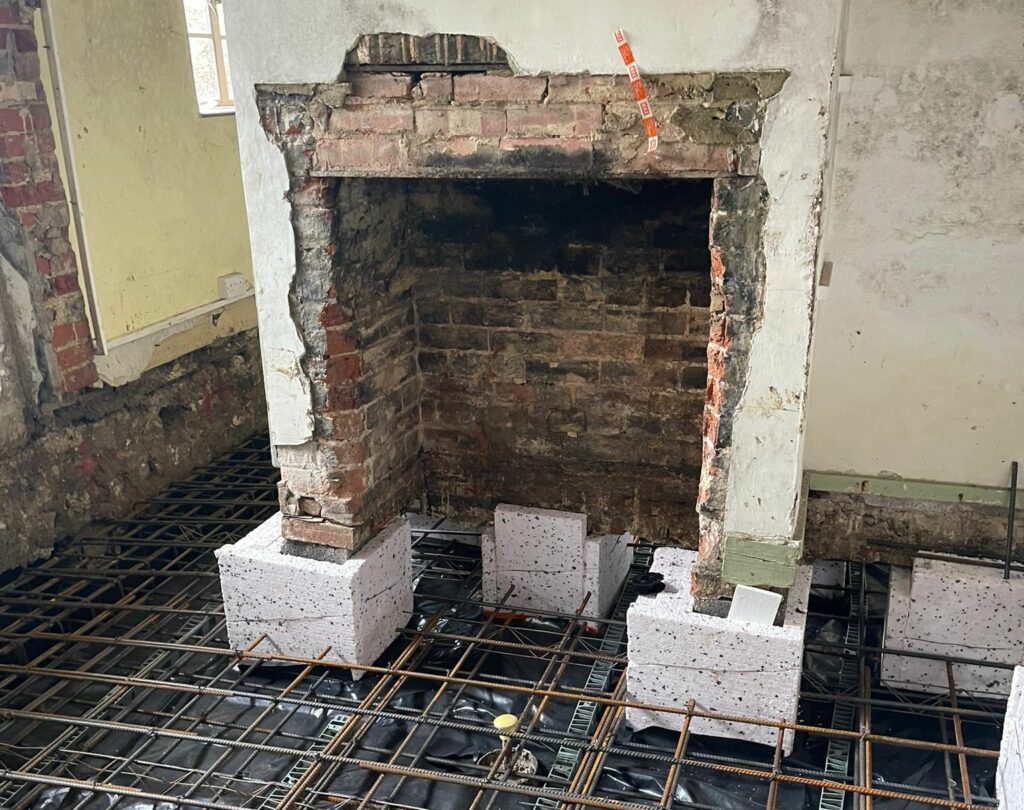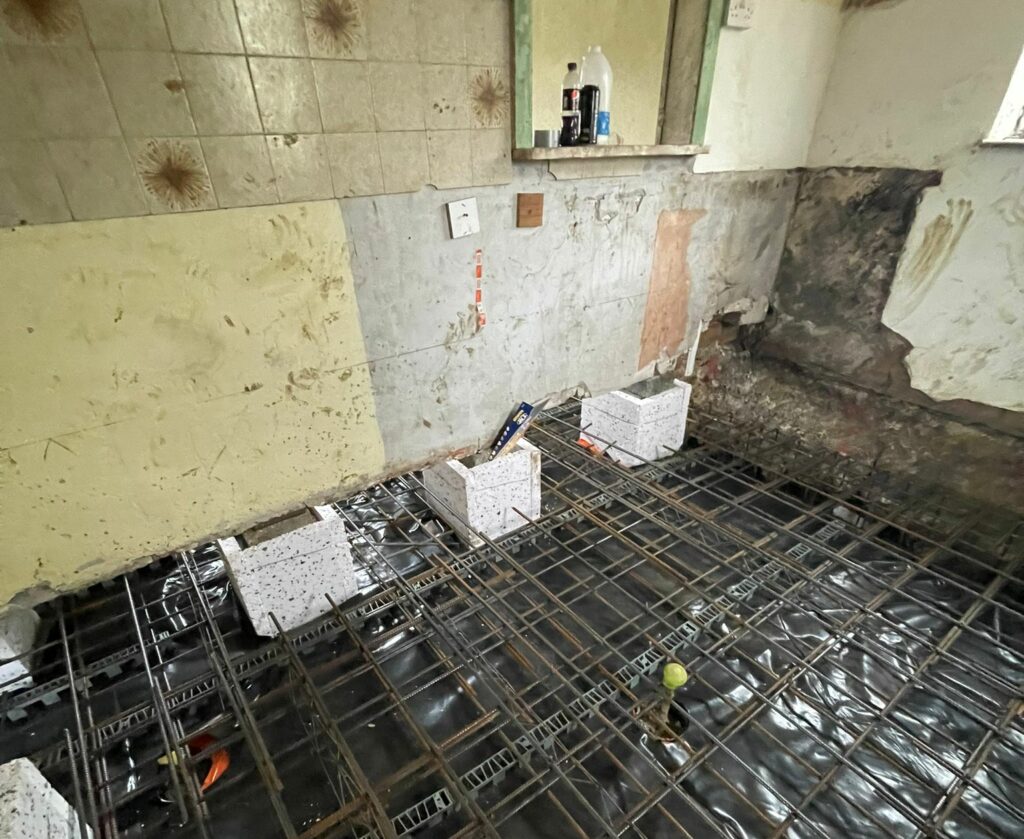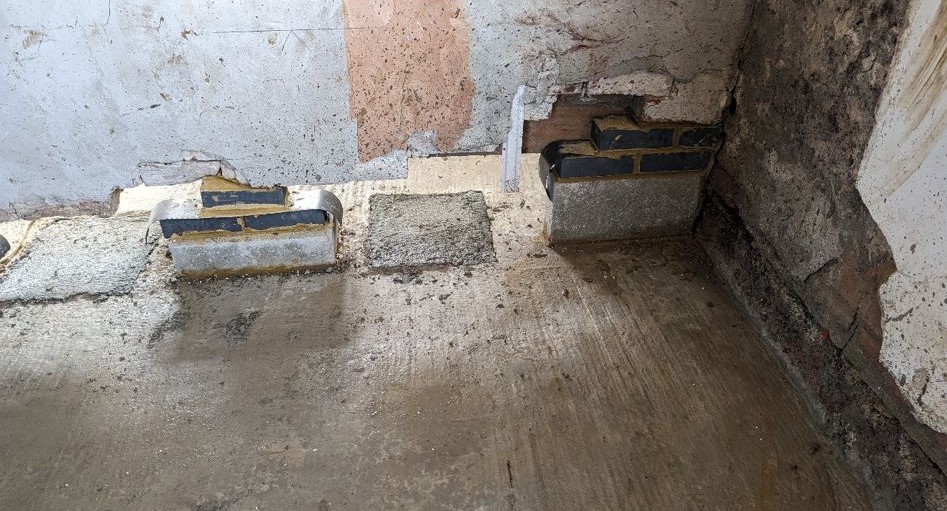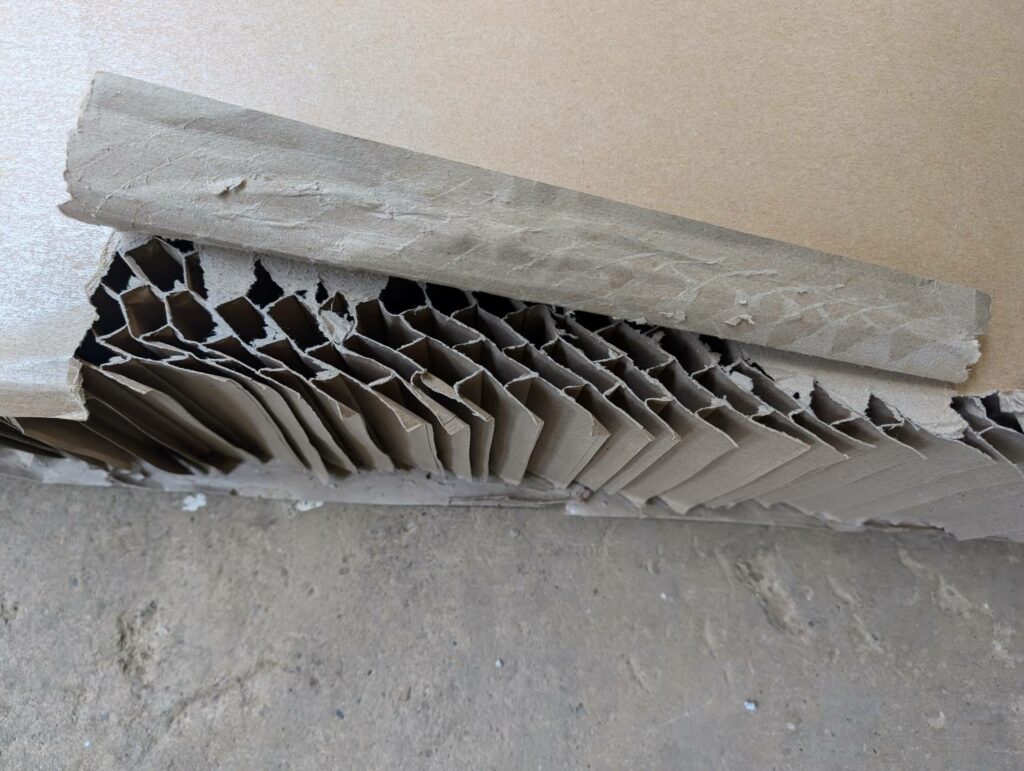Full piled raft to cure subsidence in Beddingham.

When we lift a building back to original level, even the fireplace needs to be raised back up.
When subsidence has affected a large section of a building, or multiple smaller sections, a full piled raft underpin is often the best and most permanent fix. In simple terms, we drive piles deep into the ground, lift the building back up to its original levels, cast a full raft of concrete under the entire building (supported by the piles) and then support the building using the new concrete raft as a brand new, solid foundation.
We were approached by consulting engineers to design and install this underpinning solution. We find that these jobs run particularly smoothly as consultant engineering firms usually approach us knowing exactly what the problem is, and in the knowledge that we know exactly how to fix it.
Cause of the subsidence.
We were told that the subsidence was likely caused by foundations cast on poor ground (potentially shrinkable clay), exacerbated by desiccation of the soil due to proximity of vegetation. Subsidence is very often linked to shrinkable clay, and we deal with this all the time. However, in these circumstances, problems (and solutions) related to heave spring immediately to mind. Curiously, although on clay, we also found that the end bearing sub soil was chalk, which adds an additional complication. These issues are not problems, per se, but they do need to be addressed at the design stage.
Shrinkable clay.
The problem with shrinkable clay soils is in the name; when they dry out, they shrink. Equally problematic, when desiccated (shrunk) clay rehydrates, it expands (or heaves). We are most likely to see heave when work affects the amount of water in the area. An obvious example is when a large thirsty tree is blamed for the subsidence and is removed. Thirsty species of tree can take huge amounts of water out of the ground. The most widely quoted species with a massive appetite for water include Oak, Willow, Aspen and Poplar, but almost any large established tree or shrub can remove large amounts of water from the surrounding area. Figures quoted often vary greatly, but it is not unusual for a large mature tree to be expected to take between 200 and 2000 litres of water from the ground during the peak growing season, per day. Removal of the tree can have a huge impact on the hydration levels of the ground. This is when heave becomes a concern. Without the tree removing such quantities of water, the ground literally swells, sometimes with such hydraulic pressure that it can move foundations and cause significant damage. This, obviously needs to be avoided. In this case we engineered a void underneath the slab to allow the ground to heave, without detriment to the building, or new foundations. Find out exactly how we do that, further down the page.
Issues with piling into chalk sub-soil.
The chalk sub soil provides us with a different, but equally interesting challenge. How do we know that when ‘driven to refusal’ the piles are actually bedded firmly on stable ground? Usually, the fact that the piles have been ‘driven to refusal’, is all we need to know; if our piling machines can no longer push the pile further into the ground, we know they have got to a suitably solid layer of ground. There are also tests we can perform to confirm this (dynamic pile load tests for example). Chalk, however, can be sneaky. Occasionally, the very fine particles of chalk can solidify, subjecting us to what we refer to as a ‘false set’. Fear not, we outsmart the sneaky chalk fines using a process called pile re-shrinking, which we carry out 7 days after the initial piling, just to make sure.
Anyway, enough background information, let’s get back to Beddingham.

As mentioned above, we jack the building back to original levels, before supporting it on a new concrete raft foundation. We do this by jacking the entire building (using jacks ‘boxed in’ with polystyrene). Once the concrete raft has set sufficiently we can then support the walls in their original position with blocks and bricks. We can then remove the polystyrene, remove the jacks, and add more concrete to the holes left by the jacking locations.
The picture below is of the same location as the one above.

For those of you fond of facts and figures, here are some facts and figures.
The slab is 225mm thick, is reinforced with H12 bars at 200mm cross centres and there is a 160mm Clayboard below to give a 150mm void under the raft to provide protection from heave (more on that in a moment).
The slab is supported by 150mm diameter, steel cased, cast in place driven piles. These steel cases were driven into the ground between 2 and 4 metres, and have a SWL of 83kN. The pile use was calculated using the Hiley formula, and meets the British Standard set out in BS8004. A safety factor or 3 was used as it is generally not possible to carry out dynamic load testing in such a confined space.
The heave protection is interesting. How on earth do we cast a huge concrete slab with a void under it?
The answer, surprisingly, is actually rather simple. We use a product called ‘Clayboard’.

Clayboard is simply a honeycomb type structure, made of cardboard. When dry, it can support a huge weight. If allowed to get wet it allows itself to deform under pressure, rather than transferring that pressure to nearby structures. We wrap in plastic whilst the concrete is poured on top, and then allow water to penetrate once its structural integrity is no longer required. Once complete, the new concrete slab is supported entirely by the piles.
For any further details regarding any of the above, or to find out how we can help you with your own subsidence issues, please get in touch below. We don’t employ sales staff. Ask to speak to Darren (our MD) or Jonathan ( our fully qualified and experienced Engineer).
